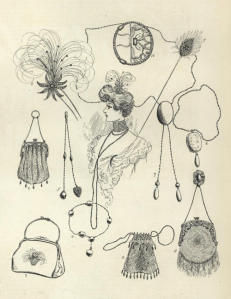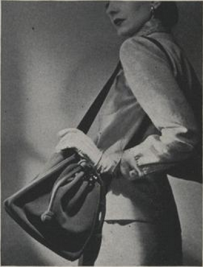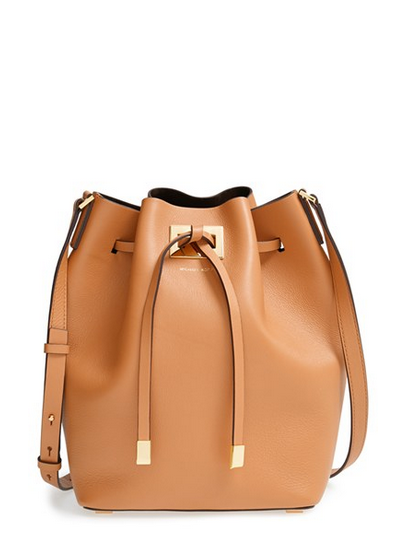


Fashion constantly mines history for inspiration. With so much already out there and so little time between collections, what’s easier than blasting back to the past and adapting something relatively obscure for next season? This was the case for the bucket bag, a small leather pouch with a drawstring closure, which has now become ubiquitous due to retailers from J.Crew to Opening Ceremony to high fashion designers such as Hedi Slimane at Saint Laurent releasing their own renditions of the highly functional yet distinct bag. However, the title of most successful rendition of the bucket bag must be awarded to Mansur Gavriel, a relatively young company founded in 2012 by Floriana Gavriel and Rochel Mansur and based out of New York City. Sleek, minimal and available in a plethora of colors, their drawstring bag became an instant classic. This month Business of Fashion named their bag the “First Post-Recession It Bag,” and it is no wonder that at the height of its influence, it is easy to forget that anything came before it.[1]

If Mansur Gavriel transformed the popularity of the bucket bag into a full-fledged craze, its return, at least in recent memory, must be attributed to the preceding surge in popularity of vintage Coach handbags, which included their version of the bucket bag. Vintage Coach bags were the perfect solution for girls with individual styles, yet could not afford the high price tags of designer bags. Vintage Coach bags flew under the radar with minimal branding or logos that would detract from the individuality of the wearer. They were crafted out of quality leather, and above all else, were affordable.



This piqued my desire to investigate the origin of the bucket bag. Where and when did it first appear in fashion and what were its major revivals leading up to today? Initially, I was ready to credit American sportswear designer, Bonnie Cashin, with the design of the modern bucket bag. Coach appointed Cashin head designer in 1962 and held the title until 1974. During her tenure, she revitalized their products making them not only fashionable but also functional, setting the precedent for the design of the highly desired vintage Coach bags we know today. Cashin’s inspiration came from quotidian objects such as the paper bag. According to Cashin, “The best-designed handbag in the world is the paper shopping bag, so I didn’t try to improve on it.”[2] Cashin designed several variations of the bucket bag that both appeared in both a Saks Fifth Avenue advertisement in 1963 and a Vogue editorial in 1967. Other popular types of bucket-style bags during the 1960s, such as one by Hermès, eliminated the drawstring feature altogether and essentially resembled a bucket tooled out of leather.


However, when perusing the pages of Vogue, it becomes immediately apparent that the origins of the classic drawstring bucket bag extended well beyond Cashin, back to at least 1900, albeit in the form of a beaded drawstring satchel, or reticule. Even more fascinating was the myriad of iterations it took throughout the years—whether as a cloud of luxurious mink by Koret

or as the perfect summer day bag complete with a wicker base.
Since the turn of the century, the bucket bag has seen three, even four, major waves of influence. Gaston-Louis Vuitton, who created one of the first modern bucket bags with the release of the Noé bag in 1932. It was originally intended as a stylish, yet sturdy method for transporting five bottles of champagne.[3] Coincidentally, as a handbag, the Noé did not become fashionable until much later. In 1939, Vogue featured a black velvet drawstring bag that they claimed harked upon “grandma’s reticule.”[4]


Perhaps the transformation of the dainty reticule into a “gargantuan drawstring pouch with a shoulder-strap” and sturdy base, coincided with the advent of WWII. According to Vogue, the new, oversized shape drew influences from a sailor’s duffle bag.[5] Designed by Koret, these bags heeded wartime rations and were crafted out of “non-priority,” yet supple bookbinding leather and black wool. Drawstring bucket bags were utilitarian, functional and roomy. A woman could stash all of her necessities inside, throw it over her shoulder and go! They appeared all throughout the pages of Vogue into the late 1940s.




The next big wave of the bucket bag crashed onto the fashion scene in the late 1980s. Re-envisioned in a plethora of jewel tones, materials, and sizes, the bucket bag fit right into the boldness of the clothing during this time. Fendi’s mini bucket

harked back to the daintiness of the reticule, but was clearly made from modern materials—bright, coral patent leather and was thoroughly modern in its structured silhouette. Clearly the drawstring bucket was the prevailing shape as Vogue did not ignore the more organic-looking versions of the bag that were crafted from “naked,” untreated leather or patterned, woven straw.


Meanwhile, fashion was having a visceral reaction to the ubiquity of designer monograms. According to Linda Donahue, an appraiser of vintage clothing, “They’re out, out, out …Initials are in poor taste. Initials are tacky. The new thing is the uncluttered look. Dull, dull, dull, but chic, chic, chic.”[6] Louis Vuitton’s updated Noé, now crafted out of their striated Epi leather (created in 1985), responded to the move of handbags towards anonymity. Featured in Vogue in 1986, the Epi Noé was indeed, discreet and understated, but still luxurious at about 50% more expensive than its monogrammed sibling. The Epi Noé stood tall with minimal hardware.

The trend of the bucket bag persisted well into the 90s. In 1993, the “roomy drawstring over-the-shoulder” bags were still being hailed by Vogue as “among the best bags of the season.”[7] Labels on both ends of the spectrum including DKNY, Coach, Salvatore Ferragamo, and Prada all created their own variations of essentially the same bag though differing slightly in silhouette or materials. The ads in the September 1994 issue of Vogue all seemed to include at least one drawstring bucket bag. While the bucket bag has never really gone out of favor, the fervor subsided during the early 2000s. Yet the recent demand for Mansur Gavriel’s bucket bags in present times merely confirms that on the one hand fashion never really dies, merely waxes and wanes; on the other, looking to fashion history for inspiration is a tried and true practice. When in doubt, or when emerging from a recession, perhaps the secret to success is to pare back and return to the classics. A tried and true silhouette like the bucket bag will always prevail.





Notes:
[1] Lauren Sherman, “How Mansur Gavriel Created the First Post-Recession It Bag,” The Business of Fashion, January 5, 2015, http://www.businessoffashion.com/2015/01/mansur-gavriel-created-first-post-recession-bag.html (accessed January 21, 2015).
[2] “Shopping Bag is Inspiration for a Handbag,” New York Times, May 29, 1965, 14.
[3] “Noé Product Description,” Louis Vuitton Website, http://us.louisvuitton.com/eng-us/products/noe-monogram-000570 (accessed January 21, 2015).
[4] Google provides the following definition for reticule: (historical) a woman’s small handbag, originally netted and typically having a drawstring and decorated with embroidery or beading.
[5] Vogue, May 1, 1943, 100.
[6] Ron Alexander, “Life Style: In the Mutable World of Chic, Designers’ Initials are Out, Simplicity Is In,” New York Times, May 21, 1989.
[7] “Pulling Strings,” Vogue, October 1993, 210.
[…] fact: Louis Vuitton introduced early modern designs in 1939 The intended purpose is to install five champagne bottles. Going to a dinner party? Bucket bags […]
LikeLike
[…] Fact: Louis Vuitton produced an early modern design in 1939 with the intended purpose of fitting five champagne bottles. Attending a dinner party? A bucket bag […]
LikeLike
[…] 于1963年推出的水桶包广告。(图片取自网络) […]
LikeLike
[…] Noé by Gaston- Louis Vuitton, is believed to be the first modern bucket bag. The need to transport Champagne in 1939 gave rise to this handbag. The Noé could comfortably carry five […]
LikeLike
[…] Since the turn of the century, the bucket bag has seen three, even four, major waves of influence. Louis Vuitton created one of the first modern bucket bags with the release of the Noé bag in 1932. It was originally intended as a stylish, yet sturdy method for transporting five bottles of champagne. Coincidentally, as a handbag, the Noé did not become fashionable until much later.” – The Art of Dress […]
LikeLike
[…] a version of the bucket bag in 1932 with its Noé bag. Its purpose was to carry champagne bottles (The Art of Dress). It’s pretty genius if you ask me. Later designs came in the 1960’s from Coach and […]
LikeLike
I too became intrigued and was curious to know the original designer when I saw a picture, whether it’s real or not I don’t know, of Marilyn Monroe sporting a bucket bag.
http://nomoredirtylooks.com/2016/01/renatas-morning-skin-and-hair-routine-exposed/
LikeLike
[…] 30, na França, e sua principal utilidade era levar garrafas de champanhe com estilo! Chique né? (Fonte aqui). Ela teve seu boom na década de 90, e agora a bolsa saco voltou com tudo e pelo jeito sem tempo […]
LikeLike
[…] Also, they could claim that a drawstring closure is what defines a bucket bag, a bag which has a history, as its popularity has come and gone in the last one hundred years or so. Defendants should be well […]
LikeLike
This is so informative and interesting! thank you!
LikeLike
[…] Įkvėpimas – čia […]
LikeLike
[…] Mas como sempre lhes informo, a moda é cíclica e essa modinha não foge a regra! Pesquisando sobre o assunto desvendei que a bolsa saco teve sua origem em meados dos anos 1.900, quando o designer Gaston-Louis Vuitton, criou um dos primeiros modelos modernos da bolsa saco com o lançamento do saco de Noé, em 1932. Ele foi originalmente concebido como um método elegante para o transporte de cinco garrafas de champanhe! Siiiim, a bolsa saco foi criada para o transporte de champanhe!!! (Puro luxo) Fonte […]
LikeLike